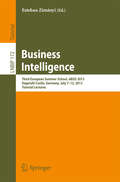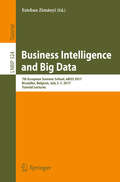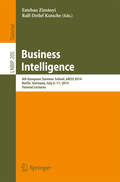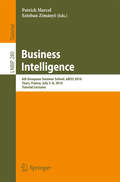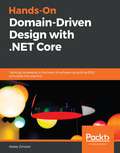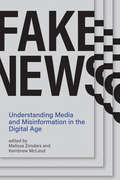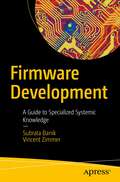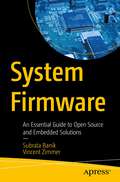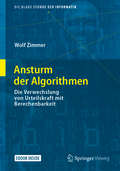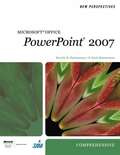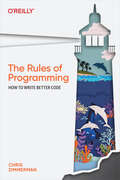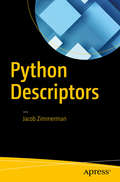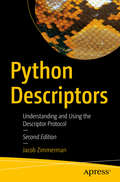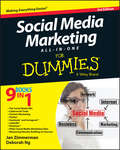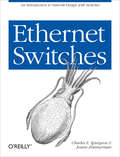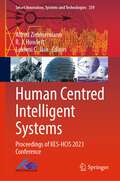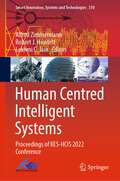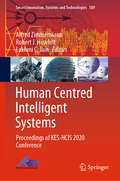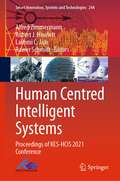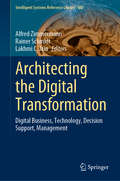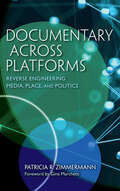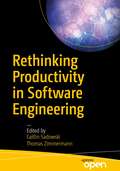- Table View
- List View
Business Intelligence: Third European Summer School, eBISS 2013, Dagstuhl Castle, Germany, July 7-12, 2013, Tutorial Lectures (Lecture Notes in Business Information Processing #172)
by Esteban ZimányiTo large organizations, business intelligence (BI) promises the capability of collecting and analyzing internal and external data to generate knowledge and value, thus providing decision support at the strategic, tactical, and operational levels. BI is now impacted by the "Big Data" phenomena and the evolution of society and users. In particular, BI applications must cope with additional heterogeneous (often Web-based) sources, e. g. , from social networks, blogs, competitors', suppliers', or distributors' data, governmental or NGO-based analysis and papers, or from research publications. In addition, they must be able to provide their results also on mobile devices, taking into account location-based or time-based environmental data. The lectures held at the Third European Business Intelligence Summer School (eBISS), which are presented here in an extended and refined format, cover not only established BI and BPM technologies, but extend into innovative aspects that are important in this new environment and for novel applications, e. g. , pattern and process mining, business semantics, Linked Open Data, and large-scale data management and analysis. Combining papers by leading researchers in the field, this volume equips the reader with the state-of-the-art background necessary for creating the future of BI. It also provides the reader with an excellent basis and many pointers for further research in this growing field.
Business Intelligence and Big Data: 7th European Summer School, eBISS 2017, Bruxelles, Belgium, July 2–7, 2017, Tutorial Lectures (Lecture Notes in Business Information Processing #324)
by Esteban ZimányiThis book constitutes revised tutorial lectures of the 7th European Business Intelligence and Big Data Summer School, eBISS 2017, held in Bruxelles, Belgium, in July 2017. The tutorials were given by renowned experts and covered advanced aspects of business intelligence and big data. This summer school, presented by leading researchers in the field, represented an opportunity for postgraduate students to equip themselves with the theoretical, practical, and collaboration skills necessary for developing challenging business intelligence applications.
Business Intelligence: 4th European Summer School, eBISS 2014, Berlin, Germany, July 6-11, 2014, Tutorial Lectures (Lecture Notes in Business Information Processing #205)
by Esteban Zimányi Ralf-Detlef KutscheThis book constitutes the tutorial lectures of the 4th European Business Intelligence Summer School, eBISS 2014, held in Berlin, Germany, in July 2014. The tutorials presented here in an extended and refined format were given by renowned experts and cover topics including requirements engineering for decision-support systems, visual analytics of large data sets, linked data and semantic technologies, supervised classification on data streams, and knowledge reuse in large organizations.
Business Intelligence: 6th European Summer School, eBISS 2016, Tours, France, July 3-8, 2016, Tutorial Lectures (Lecture Notes in Business Information Processing #280)
by Esteban Zimányi Patrick MarcelBusiness Intelligence (BI) promises an organization the capability of collecting and analyzing internal and external data to generate knowledge and value, providing decision support at the strategic, tactical, and operational levels. Business Intelligence is now impacted by the Big Data phenomena and the evolution of society and users, and needs to take into account high-level semantics, reasoning about unstructured and structured data, and to provide a simplified access and better understanding of diverse BI tools accessible trough mobile devices. In particular, BI applications must cope with additional heterogeneous (often Web-based) sources, e. g. , from social networks, blogs, competitors', suppliers', or distributors' data, governmental or NGO-based analysis and papers, or from research publications. The lectures held at the First European Business Intelligence Summer School (eBISS), which are presented here in an extended and refined format, cover not only established BI technologies like data warehouses, OLAP query processing, or performance issues, but extend into new aspects that are important in this new environment and for novel applications, e. g. , semantic technologies, social network analysis and graphs, services, large-scale management, or collaborative decision making. Combining papers by leading researchers in the field, this volume will equip the reader with the state-of-the-art background necessary for inventing the future of BI. It will also provide the reader with an excellent basis and many pointers for further research in this growing field.
Hands-On Domain-Driven Design with .NET Core: Tackling complexity in the heart of software by putting DDD principles into practice
by Alexey ZimarevSolve complex business problems by understanding users better, finding the right problem to solve, and building lean event-driven systems to give your customers what they really wantKey FeaturesApply DDD principles using modern tools such as EventStorming, Event Sourcing, and CQRSLearn how DDD applies directly to various architectural styles such as REST, reactive systems, and microservicesEmpower teams to work flexibly with improved services and decoupled interactionsBook DescriptionDevelopers across the world are rapidly adopting DDD principles to deliver powerful results when writing software that deals with complex business requirements. This book will guide you in involving business stakeholders when choosing the software you are planning to build for them. By figuring out the temporal nature of behavior-driven domain models, you will be able to build leaner, more agile, and modular systems.You’ll begin by uncovering domain complexity and learn how to capture the behavioral aspects of the domain language. You will then learn about EventStorming and advance to creating a new project in .NET Core 2.1; you’ll also and write some code to transfer your events from sticky notes to C#. The book will show you how to use aggregates to handle commands and produce events. As you progress, you’ll get to grips with Bounded Contexts, Context Map, Event Sourcing, and CQRS. After translating domain models into executable C# code, you will create a frontend for your application using Vue.js. In addition to this, you’ll learn how to refactor your code and cover event versioning and migration essentials.By the end of this DDD book, you will have gained the confidence to implement the DDD approach in your organization and be able to explore new techniques that complement what you’ve learned from the book.What you will learnDiscover and resolve domain complexity together with business stakeholdersAvoid common pitfalls when creating the domain modelStudy the concept of Bounded Context and aggregateDesign and build temporal models based on behavior and not only dataExplore benefits and drawbacks of Event SourcingGet acquainted with CQRS and to-the-point read models with projectionsPractice building one-way flow UI with Vue.jsUnderstand how a task-based UI conforms to DDD principlesWho this book is forThis book is for .NET developers who have an intermediate level understanding of C#, and for those who seek to deliver value, not just write code. Intermediate level of competence in JavaScript will be helpful to follow the UI chapters.
Fake News: Understanding Media and Misinformation in the Digital Age (Information Policy)
by Melissa Zimdars Kembrew McLeodNew perspectives on the misinformation ecosystem that is the production and circulation of fake news.What is fake news? Is it an item on Breitbart, an article in The Onion, an outright falsehood disseminated via Russian bot, or a catchphrase used by a politician to discredit a story he doesn't like? This book examines the real fake news: the constant flow of purposefully crafted, sensational, emotionally charged, misleading or totally fabricated information that mimics the form of mainstream news. Rather than viewing fake news through a single lens, the book maps the various kinds of misinformation through several different disciplinary perspectives, taking into account the overlapping contexts of politics, technology, and journalism.The contributors consider topics including fake news as “disorganized” propaganda; folkloric falsehood in the “Pizzagate” conspiracy; native advertising as counterfeit news; the limitations of regulatory reform and technological solutionism; Reddit's enabling of fake news; the psychological mechanisms by which people make sense of information; and the evolution of fake news in America. A section on media hoaxes and satire features an oral history of and an interview with prankster-activists the Yes Men, famous for parodies that reveal hidden truths. Finally, contributors consider possible solutions to the complex problem of fake news—ways to mitigate its spread, to teach students to find factually accurate information, and to go beyond fact-checking.ContributorsMark Andrejevic, Benjamin Burroughs, Nicholas Bowman, Mark Brewin, Elizabeth Cohen, Colin Doty, Dan Faltesek, Johan Farkas, Cherian George, Tarleton Gillespie, Dawn R. Gilpin, Gina Giotta, Theodore Glasser, Amanda Ann Klein, Paul Levinson, Adrienne Massanari, Sophia A. McClennen, Kembrew McLeod, Panagiotis Takis Metaxas, Paul Mihailidis, Benjamin Peters, Whitney Phillips, Victor Pickard, Danielle Polage, Stephanie Ricker Schulte, Leslie-Jean Thornton, Anita Varma, Claire Wardle, Melissa Zimdars, Sheng Zou
Firmware Development: A Guide to Specialized Systemic Knowledge
by Vincent Zimmer Subrata BanikBuild your own system firmware. This book helps you understand system firmware architecture and minimalistic design, and provides a specialized knowledge of firmware development. The book includes guidance on understanding the system firmware build procedure, integrating pieces of firmware and allowing configuration, updating system firmware, creating a development infrastructure for allowing multi-party collaboration in firmware development, and gaining advanced system firmware debugging knowledge.After reading the book you will be able to assume better control while developing your own firmware and know how to interact with native hardware while debugging. You will understand key principles for future firmware development using newer technology, and be ready for the introduction of modern safe programming languages for firmware development. Detailed system firmware development case studies using a futuristic approach cover:Future scalable system firmware development modelsTypes of firmware development (system firmware, device firmware, manageability firmware)Tools and their usage while creating system firmwareHow to build infrastructure for seamless firmware development using a multi-party development modelDebugging methodologies used during various phases of firmware product developmentSetting up key expectations for future firmware, including thinner firmware footprints and faster execution time, easier configuration, and increased transparent security What You Will LearnUnderstand the system firmware working model of the futureGain knowledge to say goodbye to proprietary firmware for different types of firmware developmentKnow the different types of tools required for creating firmware source code before flashing the final image into the boot device of the embedded systemDevelop skills to understand the failure in firmware or in the system and prepare the debugging environment to root cause the defectsDiscern the platform minimal security requirementOptimize the system firmware boot time based on the target hardware requirementComprehend the product development cycle using open source firmware development Who This Book Is For Embedded firmware and software engineers migrating the product development from closed source firmware to open source firmware for product adaptation needs as well as engineers working for open source firmware development. A secondary audience includes engineers working on various bootloaders such as open source firmware, UEFI, and Slim Bootloader development, as well as undergraduate and graduate students working on developing firmware skill sets.
System Firmware: An Essential Guide to Open Source and Embedded Solutions
by Vincent Zimmer Subrata BanikFind the right bootloader solution or combination of firmware required to boot a platform considering its security, product features, and optimized boot solutions. This book covers system boot firmware, focusing on real-world firmware migration from closed source to open source adaptation. The book provides an architectural overview of popular boot firmware. This includes both closed sourced and/or open source in nature, such as Unified Extensible Firmware Interface (UEFI), coreboot, and Slim Bootloader and their applicable market segments based on product development and deployment requirements. Traditional system firmware is often complex and closed sourced whereas modern firmware is still a kind of hybrid between closed and open source. But what might a future firmware model look like? The most simplistic boot firmware solution uses open source firmware development. This book helps you decide how to choose the right boot firmware for your products and develop your own boot firmware using open source. Coverage includes: Why open source firmware is used over closed sourceThe pros and cons of closed and open source firmwareA hybrid work model: for faster bring-up activity using closed source, binary integrated with open source firmware What You Will LearnUnderstand the architecture of standard and popular boot firmwarePick the correct bootloader for your required target hardwareDesign a hybrid workflow model for the latest chipset platformUnderstand popular payload architectures and offerings for embedded systemsSelect the right payload for your bootloader solution to boot to the operating systemOptimize the system firmware boot time based on your target hardware requirementKnow the product development cycle using open source firmware developmentWho This Book Is For Embedded firmware and software engineers migrating the product development from closed source firmware to open source firmware for product adaptation needs as well as engineers working for open source firmware development. A secondary audience includes engineers working on various bootloaders such as open source firmware, UEFI, and Slim Bootloader development, as well as undergraduate and graduate students working on developing firmware skill sets.
Ansturm der Algorithmen: Die Verwechslung von Urteilskraft mit Berechenbarkeit (Die blaue Stunde der Informatik)
by Wolf ZimmerDer durch die „Blumenkinder“ des Silicon Valley entfesselte digitale Rausch droht, die Vernunft durch den Aberglauben zu ersetzen, man könne die Welt rechnend vervollkommnen. Wer aber glaubt, die Probleme einer ungewissen Welt mit technologischen Gewissheiten lösen zu können, hat weder etwas von der Welt noch etwas von der Technologie verstanden. Im digitalen Sittenbild aus Silizium und Statistik ersetzt Rechnen das Denken, Wahrscheinlichkeit wird für Wahrheit ausgegeben und Korrelation verdrängt Kausalität. Die Hohepriester der Digitalisierung fragen nicht, ob wir das, was sie verkünden, für gut und richtig halten. Gut und richtig sind keine Kategorien des Digitalen.
New Perspectives on Microsoft® Office PowerPoint® 2007: Comprehensive
by Beverly B. Zimmerman S. Scott ZimmermanFollowing the critical thinking, problem-solving approach of the New Perspectives Series learners will gain a comprehensive understanding of Microsoft PowerPoint 2007, including the new features of the software. The case-based tutorials challenge learners to apply what they are learning to real-life tasks, preparing them to easily transfer skills to new situations. With the New Perspectives Series approach, learners understand why they're learning what they're learning, and are better situated to retain skills.
The Rules of Programming
by Chris ZimmermanThis philosophy-of-programming guide presents a unique and entertaining take on how to think about programming. A collection of 21 pragmatic rules, each presented in a standalone chapter, captures the essential wisdom that every freshly minted programmer needs to know and provides thought-provoking insights for more seasoned programmers. Author Chris Zimmerman, cofounder of the video game studio Sucker Punch Productions, teaches basic truths of programming by wrapping them in memorable aphorisms and driving them home with examples drawn from real code. This practical guide also helps managers looking for ways to train new team members. The rules in this book include: As simple as possible, but no simplerLet your code tell its own storyLocalize complexityGeneralization takes three examplesWork backward from your result, not forward from your codeThe first lesson of optimization is don't optimizeA good name is the best documentationBugs are contagiousEliminate failure casesCode that isn't running doesn't workSometimes you just need to hammer the nails
Python Descriptors
by Jacob ZimmermanThis short book on Python descriptors is a collection of knowledge and ideas from many sources on dealing with and creating descriptors. And, after going through the things all descriptors have in common, the author explores ideas that have multiple ways of being implemented as well as completely new ideas never seen elsewhere before. This truly is a comprehensive guide to creating Python descriptors. As a bonus: A pip install-able library, descriptor_tools, was written alongside this book and is an open source library on GitHub. There aren't many good resources out there for writing Python descriptors, and extremely few books. This is a sad state of affairs, as it makes it difficult for Python developers to get a really good understanding of how descriptors work and the techniques to avoid the big gotchas associated with working with them. What You Will Learn Discover descriptor protocols Master attribute access and how it applies to descriptors Make descriptors and discover why you should Store attributes Create read-only descriptors and _delete() Explore the descriptor classes Apply the other uses of descriptors and more Who This Book Is For Experienced Python coders, programmers and developers.
Python Descriptors: Understanding and Using the Descriptor Protocol
by Jacob ZimmermanCreate descriptors and see ideas and examples of how to use descriptors effectively. In this short book, you’ll explore descriptors in general, with a deep explanation of what descriptors are, how they work, and how they're used. Once you understand the simplicity of the descriptor protocol, the author delves into using and creating descriptors in practice, with plenty of tips, patterns, and real-world guidance. Because descriptors are inherently flexible, you’ll work with multiple examples illustrating how to best take advantage of them.This second edition includes additions throughout, including new material covering the set_name_() descriptors, new and improved flowcharts to explain the inner workings of descriptors, and a completely new chapter to address instance-level attributes, the easiest way to create descriptors correctly the first time. Although brief, Python Descriptors is a comprehensive guide to creating Python descriptors, including a pip install-able library called descriptor_tools, which was written alongside this book and is an open source library on GitHub. After reading this book, you will have a solid understanding of how descriptors work and the techniques to avoid the big gotchas associated with working with them.What You Will LearnDiscover descriptor protocolsMaster attribute access and how it applies to descriptorsBuild your own descriptorsUse descriptors to store attributesCreate read-only descriptors Explore the descriptor classesApply the other uses of descriptors Who This Book Is ForExperienced Python coders, programmers, and developers.
Social Media Marketing All-in-One For Dummies
by Jan Zimmerman Deborah NgLearn the latest social media marketing techniquesSocial media continues to evolve at breakneck speed, and the savvy marketer needs to keep up. This bestselling guide to social media marketing has been completely updated to cover the newest vehicles, including Groupon and Rue La La, location-based services like Foursquare, and new social networking sites like Google+ and Pinterest. Checklists, case studies, and examples will help you decide the best places to spend your marketing dollars, and you'll learn about valuable social media tools and analytics methods that can help you assess the success of your efforts.A completely updated, all-in-one guide to social media marketing, a valuable way for businesses to reach current and new customers, assist customers with problems, and complete transactionsCovers the latest sites and location-based services including Groupon, Rue La La, Foursquare, Google+, Pinterest, and moreMinibooks examine the social media mix; tools and techniques; using content to grow your brand; Twitter, Facebook, Pinterest, and Google+ marketing; other sites; and how to measure results and build on successThe perfect guidebook for the social media strategist, website manager, marketer, publicist, or anyone in charge of implementing and managing an organization's social media strategySocial Media Marketing All-in-One For Dummies, 2nd Edition helps you get the most from every minute and dollar you spend on marketing.
Ethernet Switches: An Introduction to Network Design with Switches
by Joann Zimmerman Charles E. SpurgeonIf you're ready to build a large network system, this handy excerpt from Ethernet: The Definitive Guide, Second Edition gets you up to speed on a basic building block: Ethernet switches. Whether you're working on an enterprise or campus network, data center, or Internet service provider network, you'll learn how Ethernet switches function and how they're used in network designs. This brief tutorial also provides an overview of the most important features found in switches, from the basics to more advanced features found in higher-cost and specialized switches. Get an overview of basic switch operation, the spanning tree protocol, and switch performance issues Learn about switch management and some of the most widely used switch features Discover how a hierarchical design can help maintain stable network operations Delve into special-purpose switches, such as multi-layer, access, stacking, and wireless access-point switches Learn about advanced switch features designed for specific networking environments Dive deeper into switches, with a list of protocol and package documentation
New Perspectives on Microsoft® Office Word 2007: Comprehensive
by S. Scott Zimmerman Beverly B. Zimmerman Ann Shaffer Katherine T. PinardFollowing the critical thinking, problem-solving approach of the New Perspectives Series learners will gain a comprehensive understanding of Microsoft Word 2007, including the new features of the software. The case-based tutorials challenge learners to apply what they are learning to real-life tasks, preparing them to easily transfer skills to new situations. With the New Perspectives Series approach, learners understand why they?re learning what they?re learning, and are better situated to retain skills.
Human Centred Intelligent Systems: Proceedings of KES-HCIS 2023 Conference (Smart Innovation, Systems and Technologies #359)
by Alfred Zimmermann R. J. Howlett Lakhmi C. JainThe volume includes papers presented at the International KES Conference on Human Centred Intelligent Systems 2023 (KES HCIS 2023), held in Rome, Italy on June 14–16, 2023. This book highlights new trends and challenges in intelligent systems, which play an important part in the digital transformation of many areas of science and practice. It includes papers offering a deeper understanding of the human-centred perspective on artificial intelligence, of intelligent value co-creation, ethics, value-oriented digital models, transparency, and intelligent digital architectures and engineering to support digital services and intelligent systems, the transformation of structures in digital businesses and intelligent systems based on human practices, as well as the study of interaction and the co-adaptation of humans and systems.
Human Centred Intelligent Systems: Proceedings of KES-HCIS 2022 Conference (Smart Innovation, Systems and Technologies #310)
by Alfred Zimmermann Robert J. Howlett Lakhmi C. JainThe volume includes papers presented at the International KES Conference on Human Centred Intelligent Systems 2022 (KES HCIS 2022), held in Rhodes, Greece on June 20–22, 2022. This book highlights new trends and challenges in intelligent systems, which play an important part in the digital transformation of many areas of science and practice. It includes papers offering a deeper understanding of the human-centred perspective on artificial intelligence, of intelligent value co-creation, ethics, value-oriented digital models, transparency, and intelligent digital architectures and engineering to support digital services and intelligent systems, the transformation of structures in digital businesses and intelligent systems based on human practices, as well as the study of interaction and the co-adaptation of humans and systems.
Human Centred Intelligent Systems: Proceedings of KES-HCIS 2020 Conference (Smart Innovation, Systems and Technologies #189)
by Alfred Zimmermann Robert J. Howlett Lakhmi C. JainThis book highlights new trends and challenges in intelligent systems, which play an important part in the digital transformation of many areas of science and practice. It includes papers offering a deeper understanding of the human-centred perspective on artificial intelligence, of intelligent value co-creation, ethics, value-oriented digital models, transparency, and intelligent digital architectures and engineering to support digital services and intelligent systems, the transformation of structures in digital businesses and intelligent systems based on human practices, as well as the study of interaction and the co-adaptation of humans and systems. All papers were originally presented at the International KES Conference on Human Centred Intelligent Systems 2020 (KES HCIS 2020), held on June 17–19, 2020, in Split, Croatia.
Human Centred Intelligent Systems: Proceedings of KES-HCIS 2021 Conference (Smart Innovation, Systems and Technologies #244)
by Alfred Zimmermann Robert J. Howlett Lakhmi C. Jain Rainer SchmidtThis book highlights new trends and challenges in intelligent systems, which play an essential part in the digital transformation of many areas of science and practice. It includes papers offering a deeper understanding of the human-centred perspective on artificial intelligence, of intelligent value co-creation, ethics, value-oriented digital models, transparency, and intelligent digital architectures and engineering to support digital services and intelligent systems, the transformation of structures in digital business and intelligent systems based on human practices, as well as the study of interaction and co-adaptation of humans and systems. All papers were originally presented at the International KES Conference on Human Centred Intelligent Systems 2021 (KES HCIS 2021) held on June 14–16, 2021 in the KES Virtual Conference Centre.
Architecting the Digital Transformation: Digital Business, Technology, Decision Support, Management (Intelligent Systems Reference Library #188)
by Alfred Zimmermann Rainer Schmidt Lakhmi C. JainThis research-oriented book presents key contributions on architecting the digital transformation. It includes the following main sections covering 20 chapters: · Digital Transformation · Digital Business · Digital Architecture · Decision Support · Digital Applications Focusing on digital architectures for smart digital products and services, it is a valuable resource for researchers, doctoral students, postgraduates, graduates, undergraduates, academics and practitioners interested in digital transformation.
Architektur der digitalen Transformation: Digital Business, Technologie, Entscheidungsunterstützung, Management
by Alfred Zimmermann Rainer Schmidt Lakhmi C. JainDieses forschungsorientierte Buch enthält wichtige Beiträge zur Gestaltung der digitalen Transformation. Es umfasst die folgenden Hauptabschnitte in 20 Kapiteln:- Digitale Transformation- Digitales Geschäft- Digitale Architektur- Entscheidungshilfe- Digitale Anwendungen Es konzentriert sich auf digitale Architekturen für intelligente digitale Produkte und Dienstleistungen und ist eine wertvolle Ressource für Forscher, Doktoranden, Postgraduierte, Absolventen, Studenten, Akademiker und Praktiker, die sich für die digitale Transformation interessieren.
Das Hidden-Markov-Modell: Zufallsprozesse mit verborgenen Zuständen und ihre wahrscheinlichkeitstheoretischen Grundlagen (essentials)
by Karl-Heinz ZimmermannIm Mittelpunkt dieses essentials steht eine Einführung in ein bekanntes statistisches Modell, das Hidden-Markov-Modell.Damit können Probleme bewältigt werden, bei denen aus einer Folge von Beobachtungen auf die wahrscheinlichste zustandsspezifische Beschreibung geschlossen werden soll.Die Anwendungen des Hidden-Markov-Modells liegen hauptsächlich in den Bereichen Bioinformatik, Computerlinguistik, maschinelles Lernen und Signalverarbeitung.In diesem Büchlein werden die beiden zentralen Problemstellungen in HMMs behandelt.Das Problem der Inferenz wird mit dem berühmten Viterbi-Algorithmus gelöst, und das Problem der Parameterschätzung wird mit zwei bekannten Methoden angegangen (Erwartungsmaximierung und Baum-Welch).
Documentary Across Platforms: Reverse Engineering Media, Place, and Politics
by Patricia R. ZimmermannEssays “capturing media ecologies as varied as museum installations, film festival showings, photography, and multiple varieties of internet sharing.” —Jump CutIn Documentary Across Platforms, noted scholar of film and experimental media Patricia R. Zimmermann offers a glimpse into the ever-evolving constellation of practices known as “documentary” and the way in which they investigate, engage with, and interrogate the world.Collected here for the first time are her celebrated essays and speculations about documentary, experimental, and new media published outside of traditional scholarly venues. These essays envision documentary as a complex ecology composed of different technologies, sets of practices, and specific relationships to communities, engagement, politics, and social struggles. Through the lens of reverse engineering—the concept that ideas, just like objects, can be disassembled to learn how they work and then rebuilt into something new and better—Zimmermann explores how numerous small-scale documentary works present strategies of intervention into existing power structures. Adaptive to their context, modular, and unfixed, the documentary practices she explores exploit both sophisticated high-end professional and consumer-grade amateur technologies, moving through different political terrains, different platforms, and different exhibition contexts.Together these essays demonstrate documentary’s role as a conceptual practice to think through how the world is organized and to imagine ways that it might be reorganized with actions, communities, and ideas.
Rethinking Productivity in Software Engineering
by Thomas Zimmermann Caitlin SadowskiGet the most out of this foundational reference and improve the productivity of your software teams. This open access book collects the wisdom of the 2017 "Dagstuhl" seminar on productivity in software engineering, a meeting of community leaders, who came together with the goal of rethinking traditional definitions and measures of productivity.The results of their work, Rethinking Productivity in Software Engineering, includes chapters covering definitions and core concepts related to productivity, guidelines for measuring productivity in specific contexts, best practices and pitfalls, and theories and open questions on productivity. You'll benefit from the many short chapters, each offering a focused discussion on one aspect of productivity in software engineering.Readers in many fields and industries will benefit from their collected work. Developers wanting to improve their personal productivity, will learn effective strategies for overcoming common issues that interfere with progress. Organizations thinking about building internal programs for measuring productivity of programmers and teams will learn best practices from industry and researchers in measuring productivity. And researchers can leverage the conceptual frameworks and rich body of literature in the book to effectively pursue new research directions.What You'll LearnReview the definitions and dimensions of software productivitySee how time management is having the opposite of the intended effectDevelop valuable dashboardsUnderstand the impact of sensors on productivityAvoid software development wasteWork with human-centered methods to measure productivityLook at the intersection of neuroscience and productivityManage interruptions and context-switchingWho Book Is ForIndustry developers and those responsible for seminar-style courses that include a segment on software developer productivity. Chapters are written for a generalist audience, without excessive use of technical terminology.
